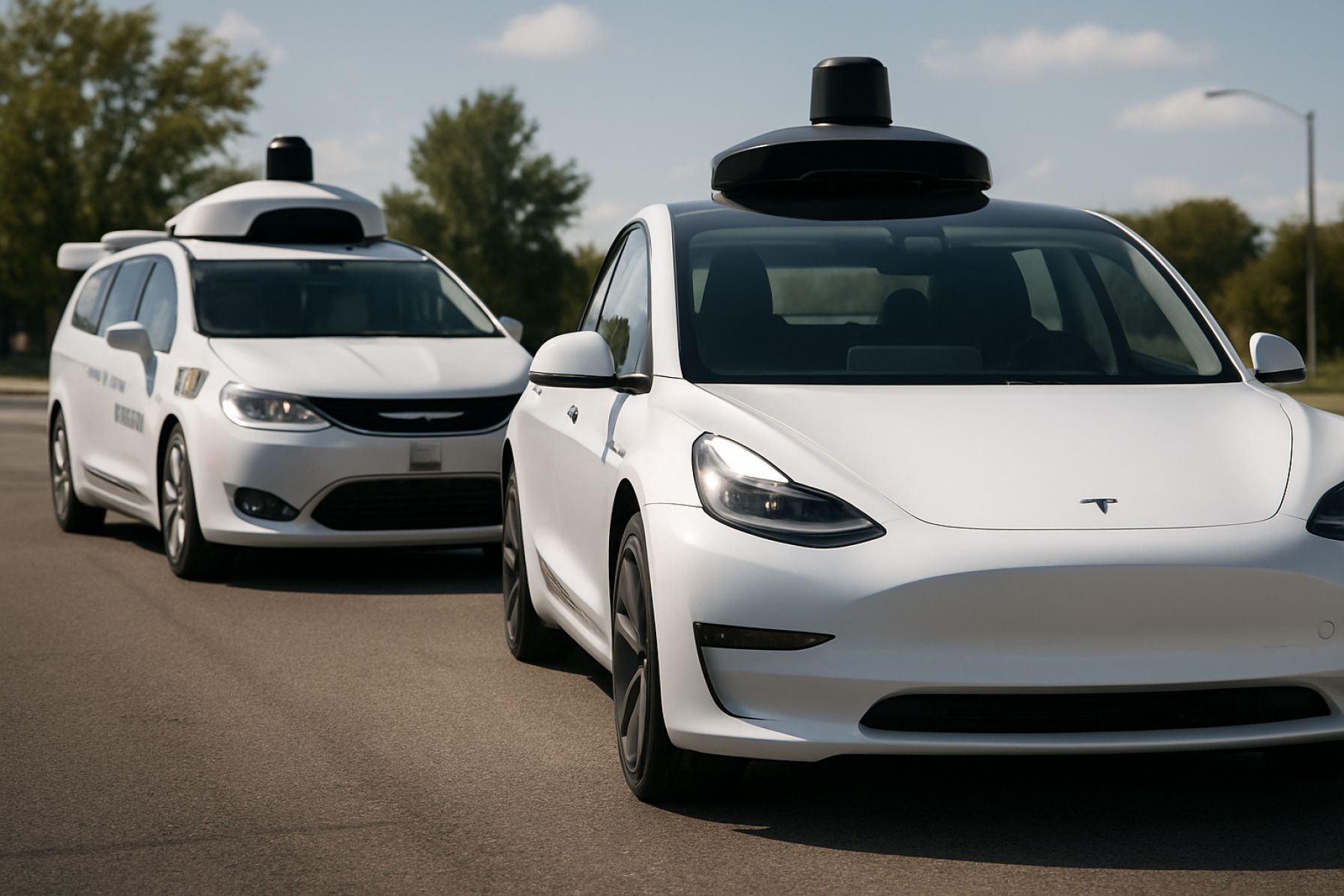- Self-driving cars and robotaxi services, led by Tesla and Waymo, are rapidly moving from prototypes to real-world city testing and deployment.
- Tesla’s robotaxi launch in Austin emphasizes bold innovation, but initial tests revealed key safety challenges compared to Waymo’s cautious, geo-fenced approach.
- The competition between Tesla and Waymo highlights crucial differences in safety, regulation, reliability, and public trust in autonomous vehicles.
- Robotaxi success could dramatically affect Tesla’s reputation and market value, increasing pressure amid tight global competition.
- Broader adoption of AI and automation, not just in driving but across industries, is transforming both the job market and expectations for future work.
Sleek, silent, and brimming with sensors, self-driving cars now prowl city streets not as prototypes, but as harbingers of seismic change for commuters and corporations alike. In Austin next month, Tesla aims to turn this futuristic promise into everyday reality, unveiling its hotly anticipated robotaxi service. With bold ambitions and market momentum, the electric car giant is poised to ignite fresh waves of both excitement and scrutiny.
Meanwhile, Waymo—backed by tech titan Google—has quietly established its own robotaxi fleets in cities like San Francisco, steadily racking up miles and trust through cautious, calculated deployment. Where Tesla champions bold innovation and speed, Waymo prizes precision and incremental safety. These strategies collided dramatically in a recent head-to-head, when experienced journalists put each system through its paces.
The verdict? Differences lay not merely in style, but in critical execution. Tesla’s prototype faltered at a notorious intersection, running a red light—a minor misstep with major implications for public trust. Waymo’s route, geo-fenced to skirt troublesome traffic hazards, took the scenic detour, sacrificing minutes for measurable caution. Tesla responds with plans to confine initial robotaxi operations to mapped “safe” zones within Austin, mirroring Waymo’s approach but still facing the immense pressure of sky-high expectations.
As the robotaxi arms race accelerates, big questions persist about reliability, regulation, and reputation. Tesla’s stakes soar higher than ever: buoyed by a 40% jump in stock price since CEO Elon Musk reaffirmed his dedication to the project, yet challenged by intensifying global competition and eroding used vehicle values. The robotaxi rollout, if successful, could become the brand’s redemption arc—or its greatest test.
Beyond the asphalt battlefield, the shift has begun to reshape the very pillars of white-collar work. The world’s leading professional-services firms—long synonymous with spreadsheet-wielding analysts—now face AI’s creeping automation. Once-secure knowledge jobs grow less certain, while hands-on trades like plumbing and construction are quietly ascendant, luring Gen Z talent wary of ballooning college costs and vanishing office perks.
There’s a through-line here, a subtle but seismic question: Are we really ready to trust robots with the very act of getting from point A to point B—or, for that matter, to navigate through a changing job market? As local streets become proving grounds and familiar offices face relentless automation, the choices made today will shape work, travel, and trust for decades to come.
Key takeaway: The dawn of the robotaxi isn’t just about technology—it’s about trust, adaptation, and the willingness to rethink both our daily journeys and the future of work. The race is on, and no one is guaranteed the driver’s seat.
Robotaxis: Game-Changer or Gambit? Everything You Need to Know About the Self-Driving Revolution
Unpacking the Robotaxi Race: Tesla vs. Waymo and What’s Next
The self-driving car debate is heating up as Tesla and Waymo take center stage in the robotaxi arms race. With Tesla planning its much-anticipated robotaxi launch in Austin and Waymo—powered by Google—already operating in San Francisco, the competition is no longer futuristic speculation. This new era brings up deep questions about safety, market readiness, regulation, job security, and public trust.
Let’s dive deeper, exploring essential facts and expert perspectives not fully addressed in the original article, while delivering actionable insights, how-to steps, and a clear-eyed pros and cons overview.
—
Essential Robotaxi Facts Unexplored in the Source
1. Technical Features & Capabilities
- Waymo: Uses a multi-sensor suite with LiDAR, radar, and cameras; features a custom-built self-driving software stack that has accumulated over 20 million autonomous miles on public roads and billions more in simulation. Their vehicles operate primarily in geo-fenced urban zones for optimum control and reliability. (Waymo, The Verge)
- Tesla: Relies primarily on its proprietary camera-based “Tesla Vision” and neural networks, eschewing LiDAR to keep hardware costs down. This controversial “pure vision” approach is overseen by CEO Elon Musk, who argues that advanced neural nets can match or outperform human perception without extra sensors. (Tesla, Electrek)
2. Current Coverage & Expansion Plans
- Waymo is publicly testing in Phoenix, San Francisco, Los Angeles, and Austin, with over 700 self-driving vehicles on U.S. roads (2024 data, Statista).
- Tesla’s robotaxi launch will start in limited, high-definition mapped “safe” zones in Austin. Their ambition: expand nationwide and eventually offer an Uber-like ride-hailing program, pairing existing fleet owners with paying customers (the “Tesla Network”).
3. Pricing Models & Market Potential
- Industry analysts project robotaxi rides could undercut traditional ride-hailing by 35-60% per mile, depending on regulatory costs and insurance. (McKinsey & Company, 2023)
- Autonomous vehicles are projected to become a $2 trillion global market by 2030, with robotaxis potentially capturing a $160 billion share by 2030 alone. (Allied Market Research, 2024)
—
Real-World Use Cases & Compatibility
- Urban Mobility: Waymo’s robotaxis are already providing hundreds of rides daily, mostly to early adopters and tech-savvy commuters who value safety and lower costs.
- Business Applications: Companies are piloting robotaxis for employee transportation, aiming to cut fleet management and insurance expenses.
- Accessibility: Autonomous taxis hold promise for seniors and the mobility-impaired, with in-vehicle voice assistants and dedicated accessibility features.
—
Controversies, Limitations & Pressing Questions
Reliability & Safety Record
- Incidents: Waymo vehicles have been involved in a handful of minor incidents (mostly involving being struck by human drivers). No fatalities have been reported. Tesla’s FSD Beta has faced scrutiny over multiple accidents, including the recent red light incident in public tests.
- Software Limitations: Neither Tesla’s nor Waymo’s systems currently handle unstructured environments (construction zones, complex intersections) perfectly. Human-level reasoning on the fly remains elusive.
Regulatory Hurdles
- Local bans: Some cities have paused or strictly limited autonomous vehicles after high-profile mishaps (e.g., San Francisco, Phoenix, see Reuters, 2024).
- Insurance: Insurers are still grappling with pricing policies for robotaxi providers (Insurance Journal, 2024).
Public Trust & Perception
- Recent surveys show less than 40% of Americans are comfortable with fully self-driving vehicles (Pew Research Center, 2024).
—
Pros & Cons Overview
| Pros | Cons |
|---|---|
|
|
—
Industry Trends & Predictions
- Multiple automakers (GM Cruise, Uber ATG, Baidu Apollo) are racing to keep pace, intensifying the market and regulatory race.
- Experts predict most cities will see robotaxi services in limited areas by 2027-2029, with true nationwide coverage unlikely before 2035 (Boston Consulting Group, 2023).
- Sustainability: Widespread robotaxi adoption could cut urban emissions by up to 70%—if fleets are fully electric. But energy grid readiness remains a question (IEA, 2023).
—
How To: Try a Robotaxi or Prepare for the Shift
- Check Availability: Visit the provider’s official site (e.g., Waymo, Tesla) to see if service is in your city and sign up for early rider programs.
- Prioritize Safety: Always buckle up, know how to trigger manual override or emergency stop, and report unexpected behavior to the provider.
- Stay Informed: Monitor local laws—autonomous vehicle regulations shift quickly.
- Enhance Your Skills: Consider learning tech-adjacent or hands-on trades; demand for these is rising as automation reshapes white-collar roles (LinkedIn Jobs Report, 2024).
—
Pressing Questions & Expert Answers
“Is it safe to use a robotaxi today?”
Statistically, professionally operated robotaxis have fewer at-fault accidents per million miles than the national average for human drivers (Waymo Safety Report, NHTSA data). However, software errors and unpredictable road users mean risks are not zero.
“Will robotaxis take away jobs?”
Yes, for traditional driving roles. However, new opportunities in fleet management, AI training, vehicle maintenance, and urban planning are emerging. Upskilling in these areas is key (Brookings Institution, 2024).
“How do these vehicles handle hacking or privacy concerns?”
Both Tesla and Waymo use robust, end-to-end encrypted communications and heavily restricted remote access. However, as with all connected vehicles, they are theoretically vulnerable. Cybersecurity remains an ongoing battle. (CISA)
“Should I buy a car or wait for robotaxi services?”
If you live in a test city and don’t rely on long commutes or off-the-grid travel, trying robotaxis can be cheaper and more convenient. However, nationwide, reliable coverage is still years away. Most Americans will need to own or lease for the foreseeable future.
—
Final Recommendations & Quick Tips
- Stay up to date—follow official channels like Tesla and Waymo for the latest local service launches and safety updates.
- If job security is a concern, start upskilling or exploring adjacent fields that are less susceptible to automation.
- When using early robotaxi services, provide honest feedback to providers. Public trust and quick problem-solving depend on real user input.
- Advocate for transparent safety data: Consumers should push companies and regulators to publish regular safety reports and clear data on real-world incidents.
Key Takeaway: Trust and Adaptation Will Drive the Robotaxi Revolution
The robotaxi revolution is as much about psychology, trust, and new economic realities as it is about breakthrough technology. Whether Tesla, Waymo, or a new contender claims victory, adaptation—by commuters, companies, and cities—will decide who truly gets the driver’s seat in this seismic mobility shift.









